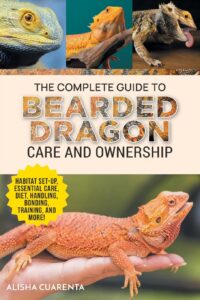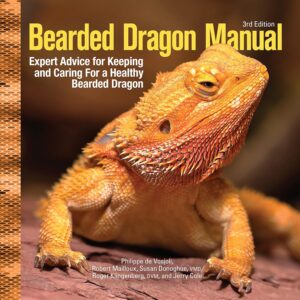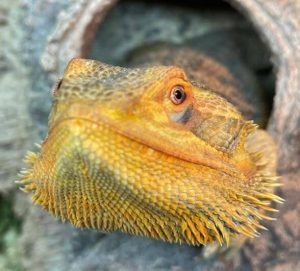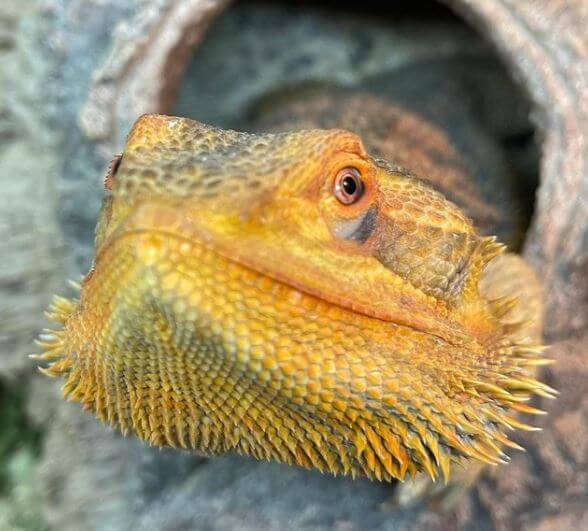How big does a bearded dragon get
How big does a bearded dragon get: Bearded dragons, scientifically known as Pogona, are among the most popular reptile pets today. With their charismatic personalities and unique appearance, they have captured the hearts of many reptile enthusiasts.
Native to Australia, these fascinating creatures have become increasingly sought after worldwide due to their docile nature and relatively easy care requirements. Understanding the growth potential of bearded dragons is crucial for any owner or prospective owner, as it allows for proper planning and ensures the well-being of these captivating companions.
Brief Overview of Bearded Dragons as Popular Reptile Pets
Bearded dragons have found a special place in the world of exotic pet keeping. Their distinctive features, including a spiky beard under their chin that they puff up as a defensive display, make them easily recognizable. They possess a friendly temperament and can become accustomed to human interaction if properly socialized from an early age.
These reptiles exhibit various color morphs, ranging from earthy browns and greens to vibrant oranges and reds. This wide array of colors has contributed significantly to their popularity among collectors who appreciate the aesthetic diversity these animals offer.
Furthermore, bearded dragons are diurnal creatures, meaning they are active during daylight hours while spending their nights resting or sleeping. This characteristic makes them an excellent choice for individuals seeking a pet that can be observed and interacted with during normal waking hours.
Importance of Understanding Their Growth Potential
 Gaining knowledge about the growth potential of bearded dragons is essential for responsible ownership. When bringing home a hatchling or juvenile dragon, it is vital to understand the approximate size range they will reach in adulthood. This understanding allows owners to provide adequate housing arrangements from the start while ensuring proper nutrition throughout each growth stage.
Gaining knowledge about the growth potential of bearded dragons is essential for responsible ownership. When bringing home a hatchling or juvenile dragon, it is vital to understand the approximate size range they will reach in adulthood. This understanding allows owners to provide adequate housing arrangements from the start while ensuring proper nutrition throughout each growth stage.
Moreover, comprehending how large a bearded dragon will grow helps establish realistic expectations regarding its long-term care requirements and overall space needs. These reptiles require sufficient room to move, bask, and even engage in light physical activities, contributing to their mental and physical well-being.
By understanding the growth potential of bearded dragons, owners also become aware of any variations in size that may indicate underlying health issues. Monitoring their growth rate can help identify potential concerns early on, allowing for timely intervention and veterinary attention if necessary.
Overall, understanding the growth potential of these captivating reptiles is fundamental for ensuring their well-being throughout their lives. By providing appropriate care and a suitable environment based on their expected size, owners can foster a healthy and fulfilling life for their beloved bearded dragons.
General Size Range
Unlocking the Mysteries of Bearded Dragon’s Dimensions
When it comes to understanding the size range of adult bearded dragons, one must delve into the fascinating world of reptilian growth patterns. On average, adult bearded dragons reach a length of 18 to 24 inches from snout to tail tip. However, it is essential to note that these measurements can vary depending on several factors, including genetics, diet, and overall health.
The primary determinant in predicting the size range of a bearded dragon lies in its genetic makeup. Just as humans inherit physical traits from their parents, bearded dragons also inherit genes that play a role in determining their adult dimensions.
Certain bloodlines may possess genes that lead to larger or smaller sizes compared to others. Breeders have selectively bred bearded dragons over generations with specific size characteristics in mind, contributing to variations observed within different lineages.
Another crucial factor influencing the growth and size potential of bearded dragons is their diet. These reptiles are omnivorous creatures with a diverse appetite ranging from insects to leafy greens.
A well-balanced diet plays a vital role in ensuring proper growth and development throughout each stage of their life cycle. Juvenile bearded dragons require higher levels of protein for rapid growth during their early stages; however, as they transition into adulthood, a more balanced ratio between protein and vegetables becomes ideal for maintaining healthy body proportions.
Factors Influencing Growth
The Intricate Interplay Between Nature and Nurture
 It is intriguing how various external factors interact with an individual bearded dragon’s genetics to influence its overall growth rate. While genetics provide the foundation for an individual’s potential size range, environmental conditions significantly impact whether this potential is fully realized.
It is intriguing how various external factors interact with an individual bearded dragon’s genetics to influence its overall growth rate. While genetics provide the foundation for an individual’s potential size range, environmental conditions significantly impact whether this potential is fully realized.
Temperature plays a crucial role in regulating metabolic processes within reptiles’ bodies. Bearded dragons require a basking spot with temperatures ranging between 95°F to 105°F to facilitate proper digestion and metabolism.
Adequate exposure to UVB lighting is equally important as it aids in calcium absorption, an essential mineral for bone development. A well-maintained temperature gradient throughout their enclosure ensures optimal growth and overall well-being.
Enclosure size also impacts a bearded dragon’s development. Providing sufficient space for exercise and exploration is not only beneficial for their mental stimulation but also encourages healthy physical growth.
Inadequate living space can result in stunted growth, muscle atrophy, and even psychological stress. The size range of adult bearded dragons typically falls between 18 to 24 inches.
However, this measurement can vary significantly depending on genetics, diet, as well as the environmental conditions provided for their care. Understanding these factors unlocks the secrets behind their growth potential and allows reptile enthusiasts to ensure that these captivating creatures reach their full size while leading happy and healthy lives.
Growth Stages
Hatchling Stage (0-3 months)
During the hatchling stage, bearded dragons are adorable little creatures that require special care and attention. At this stage, they measure around 4 to 6 inches in length, with an average weight of 10 to 20 grams. These tiny beings are highly dependent on their environment and caregivers for survival.
Providing them with a suitable habitat is crucial to ensure their growth and development. A small enclosure with proper heating and lighting is essential, along with a diet consisting of appropriately sized insects and finely chopped vegetables.

Juvenile Stage (3-12 months)
The juvenile stage is an exciting period filled with rapid growth and development for bearded dragons. During this phase, they experience a significant growth spurt, both in terms of size and weight.
The length of juvenile bearded dragons can range from 8 to 16 inches, with weights varying between 60 to120 grams. It is important to note that each dragon’s growth rate may differ slightly based on genetics and environmental factors such as diet quality and habitat conditions.
Sub-Adult Stage (12-18 months)
As bearded dragons enter the sub-adult stage, their growth rate slows down compared to their earlier phases. On average, during this period, they continue growing at a steadier pace but not as dramatically as in the juvenile phase.
Bearded dragons at this stage typically measure around 16 to 22 inches long, weighing between 200 to 400 grams depending on various factors such as genetics and nutrition. Additionally, the sub-adult stage marks the onset of secondary sexual characteristics development in males which includes enlarged hemipenal bulges located at the base of their tails.
Adult Stage (18+ months)
The adult stage represents the final size attained by bearded dragons, but it is important to note that there can be variations in size based on gender, genetics, and environmental factors. On average, adult males reach a length of 18 to 24 inches and weigh between 350 to 600 grams.
Females tend to be slightly smaller, ranging from 16 to 22 inches in length and weighing around 250 to 450 grams. However, it’s important not to focus solely on size as a measure of health or well-being; instead, consider their overall appearance, activity level, and behavior.
Factors Influencing Size
Genetics
Genetics play a significant role in determining the ultimate size of a bearded dragon. Some genetic lines have been selectively bred for larger or smaller sizes over generations.
When selecting pet bearded dragons, it’s crucial to understand the lineage and potential growth patterns associated with specific bloodlines. Breeders can provide valuable insights into the genetic potential of their offspring.
Diet
The impact of diet on a bearded dragon’s growth rate cannot be overstated. A well-balanced diet is essential for their overall development.
Feeding them appropriate amounts of protein-rich insects such as crickets or roaches along with a variety of fresh vegetables ensures they receive proper nutrition for optimal growth. Calcium supplementation is also crucial for healthy bone development.
Environmental Factors
The environment in which a bearded dragon lives greatly influences its growth potential. Temperature and lighting conditions are particularly important as they impact metabolism and overall health. Providing appropriate heat gradients within their enclosure helps regulate body temperature while UVB lighting promotes calcium absorption necessary for strong bones and proper growth.
To Sum Up How Big Does a Bearded Dragon Get
Understanding the growth stages of bearded dragons is crucial for providing them with the right care and ensuring their development into healthy adults. From the small and delicate hatchlings to the majestic adult dragons, each stage requires specific attention to nutrition, habitat, and environmental factors.
While genetics, diet, and environment significantly influence their size potential, it’s important to focus on overall well-being rather than solely on size. By providing proper care and attention throughout their growth journey, we can witness these remarkable reptiles flourish in our homes.
Further Reading:
- Carolina Custom Cages Terrarium Review
- 8 Best Basking Rocks for Beardie: What Is the Best Choice?
- 10 Best Thermometers for Beardie: How to Choose the Best One?
- 5 Best Beardie Lighting Setups for Beardie Lovers
- 9 Best Heat Lamps for Beardie: Natural Habitat Provided


